key Citroen C4 RHD 2015 2.G Owner's Guide
[x] Cancel search | Manufacturer: CITROEN, Model Year: 2015, Model line: C4 RHD, Model: Citroen C4 RHD 2015 2.GPages: 328, PDF Size: 12.72 MB
Page 117 of 328

77
115ô
Forô optimumô installation ô of ô the ô "for -
ward-facing" ô child ô seat, ô ensure ô that ô
the
ô
back
ô
of
ô
the
ô
child
ô
seat
ô
is
ô
as
ô
close
ô
as
ô
possible
ô
to
ô
the
ô
backrest
ô
of
ô
the
ô
ve
-
hicle's
ô seat, ô in ô contact ô if ô possible.
You
ô
mst
ô
remove
ô
the
ô
head
ô
restraint
ô
before
ô
installin
g ô
a
ô
child
ô
seat
ô
with
ô
backrest
ô to ô a ô passenger ô seat.
Ensure
ô
that
ô
the
ô
head
ô
restraint
ô
is
ô
stored
ô
or
ô
attached
ô
securely
ô
to
ô
pre
-
vent
ô
it
ô
from
ô
being
ô
thrown
ô
around
ô
the
ô
vehicle
ô
in
ô
the
ô
event
ô
of
ô
sharp
ô
brak
-
ing.
ô
Refit
ô
the
ô
head
ô
restraint
ô
when
ô
the
ô
child
ô seat ô is ô removed.
ADVICE ON CHILD SEATS
Installing a booster seat
Children at the frontTheô incorrect ô installation ô of ô a ô child ô seat
ô in ô a ô vehicle ô compromises ô the ô
child's
ô
protection
ô
in
ô
the
ô
event
ô
of
ô
an
ô
accident.
Ensure that there is no seat belt or
seat
ô
belt
ô
buckle
ô
under
ô
the
ô
child
ô
seat,
ô
as
ô this ô could ô destabilise ô it.
Remember
ô
to
ô
fasten
ô
the
ô
seat
ô
belts
ô
or
ô
the
ô
child
ô
seat
ô
harnesses
ô
keeping
ô
the
ô
slack
ô
relative
ô
to
ô
the
ô
child's
ô
body
ô
to
ô
a
ô
minimum,
ô even ô for ô short ô journeys.
When
ô
installin
g ô
a
ô
child
ô
seat
ô
using
ô
the
ô
seat belt, ensure that the seat belt is
tightened
ô
correctly
ô
on
ô
the
ô
child
ô
seat
ô
andô thatô it ô secures ô the ô child ô seat ô firmlyô onô theô seat ô of ô your ô vehicle. ô If ô your ô passenger
ô seat ô is ô adjustable, ô move ô
it
ô forwards ô if ô necessary.
The
ô
legislation
ô
on
ô
carrying
ô
children
ô
onô the
ô
front
ô
passenger
ô
seat
ô
is
ô
specific
ô
toô each
ô
country
. ô
Refer
ô
to
ô
the
ô
legislationô in
ô force ô in ô your ô country.
Deactivate
ô
the
ô
passenger
ô
airbag
ô
when
ô
a
ô
"rearward-facing"
ô
child
ô
seat
ô
is
ô installed ô on ô the ô front ô seat.
Otherwise,
ô
the
ô
child
ô
would
ô
risk
ô
being
ô
seriously
ô
injured
ô
or
ô
kille
d ô
if
ô
the
ô
airbag
ô
were
ô to ô inflate.The
ô
chest
ô
part
ô
of
ô
the
ô
seat
ô
belt
ô
must
ô
be
ô
positioned
ô
on
ô
the
ô
child's
ô
shoulder
ô
without
ô touching ô the ô neck.
Ensure that the lap part of the seat
belt ô
passes
ô
correctly
ô
over
ô
the
ô
child's
ô
thighs.
CITROûN
ô
recommends
ô
the
ô
use
ô
of
ô
a
ô
booster
ô
seat
ô
which
ô
has
ô
a
ô
back,
ô
fit
-
ted ô
with
ô
a
ô
seat
ô
belt
ô
guide
ô
at
ô
shoulder
ô
level.
As
ô a ô safety ô precaution, ô do ô not ô leave:
- ô a ô child ô or ô children ô alone ô and ô un -
supervised ô in ô a ô vehicle,
- ô a ô child ô or ô an ô animal ô in ô a ô vehicle ô
which
ô
is
ô
exposed
ô
to
ô
the
ô
sun,
ô
with
ô
the
ô windows ô closed,
-
ô
the
ô
keys
ô
within
ô
reach
ô
of
ô
children
ô
inside
ô the ô vehicle.
At
ô
rear
ô
seating
ô
positions,
ô
always
ô
leave
ô
sufficient
ô
space
ô
between
ô
the
ô
front
ô seat ô and:
-
ô
a
ô "rearward ô facing" ô child ô seat,
-
ô
the
ô
child's
ô
feet
ô
for
ô
a
ô
child
ô
seat
ô
fit
-
ted
ô "forward ô facing".
To
ô
do
ô
this,
ô
move
ô
the
ô
front
ô
seat
ô
for
-
wards
ô
and,
ô
if
ô
necessary
, ô
move
ô
its
ô
backrest
ô into ô the ô upright ô position. To
ô
prevent
ô
accidental
ô
opening
ô
of
ô
the
ô
doors
ô
and
ô
rear
ô
windows,
ô
use
ô
the
ô
"Child
ô lock".
Take
ô
care
ô
not
ô
to
ô
open
ô
the
ô
rear
ô
win
-
dows
ô by ô more ô than ô one ô third.
To
ô
protect
ô
young
ô
children
ô
from
ô
the
ô
rays
ô
of
ô
the
ô
sun,
ô
fit
ô
side
ô
blinds
ô
on
ô
the
ô
rear
ô windows.
CHILD SAFETY
Page 118 of 328

77
116ô
ELECTRIC CHILD LOCK
Remoteô controlô system ô to ô prevent ô opening
ô of ô the ô rear ô doors ô using ô their ô in -
terior
ô
controls
ô
and
ô
use
ô
of
ô
the
ô
rear
ô
elec
-
tric
ô windows ô .
The
ô
control
ô
is
ô
located
ô
on
ô
the
ô
dash
-
board,
ô driver's ô side.
F
ô
Press
ô this ô button.
The
ô
indicator
ô
lamp
ô
in
ô
the
ô
button
ô
comes
ô
on,
ô
accompanied
ô
by
ô
a
ô
message
ô
in
ô
the
ô
screen.
This
ô
indicator
ô
lamp
ô
remains
ô
on
ô
until
ô
the
ô
child
ô lock ô is ô switched ô off.
Switching on
Switching off
F
ô
Press
ô this ô button ô again.
The
ô
indicator
ô
lamp
ô
on
ô
button
ô
A
ô
goes
ô
of
f, ô
accompanied
ô
by
ô
a
ô
message
ô
in
ô
the
ô
screen.
This
ô
indicator
ô
lamp
ô
remains
ô
on
ô
while
ô
child
ô lock ô is ô switched ô on.This
ô
system
ô
is
ô
independent
ô
and
ô
in
ô
no
ô
circumstances
ô
does
ô
it
ô
take
ô
the
ô
place
ô
of
ô
the
ô
central
ô
locking
ô
control.
Check
ô
the
ô
status
ô
of
ô
the
ô
child
ô
lock
ô
each
ô
time
ô
you
ô
switch
ô
on
ô
the
ô
igni
-
tion.
Always
ô
remove
ô
the
ô
key
ô
from
ô
the
ô
ignition
ô
when
ô
leaving
ô
the
ô
vehi
-
cle,
ô even ô for ô a ô short ô time.
In
ô
the
ô
event
ô
of
ô
a
ô
serious
ô
impact,
ô
the
ô
electric
ô
child
ô
lock
ô
is
ô
switched
ô
of
f ô
automatically
ô
to
ô
permit
ô
the
ô
exit
ô of ô the ô rear ô passengers.
Any
ô
other
ô
status
ô
of
ô
the
ô
indica
-
tor
ô
lamp
ô
indicates
ô
a
ô
fault
ô
with
ô
the
ô
electric
ô
child
ô
lock.
ô
Have
ô
it
ô
checked
ô
by
ô
a
ô
CITROûN
ô
dealer
ô
or
ô a ô qualified ô workshop.
CHILD SAFETY
Page 127 of 328
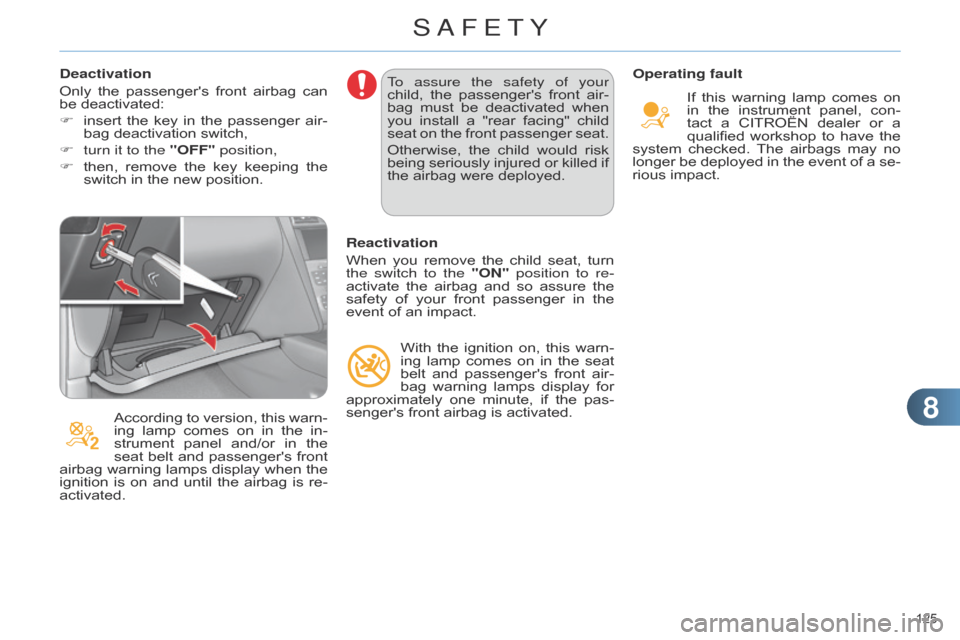
88
125ô
Deactivation
Onlyô
the
ô
passenger's
ô
front
ô
airbag
ô
can
ô
be
ô deactivated:
F
ô
insert
ô
the
ô
key
ô
in
ô
the
ô
passenger
ô
air
-
bag
ô deactivation ô switch,
F
turn it to the
"OFF" position,
F
ô
then,
ô
remove
ô
the
ô
key
ô
keeping
ô
the
ô
switch
ô in ô the ô new ô position.
According
ô
to
ô
version,
ô
this
ô
warn
-
ing
ô
lamp
ô
comes
ô
on
ô
in
ô
the
ô
in
-
strument
ô
panel
ô
and/or
ô
in
ô
the
ô
seat
ô
belt
ô
and
ô
passenger's
ô
front
ô
airbag
ô
warning
ô
lamps
ô
display
ô
when
ô
the
ô
ignition
ô
is
ô
on
ô
and
ô
until
ô
the
ô
airbag
ô
is
ô
re
-
activated. To assure the safety of your
child,
ô
the
ô
passenger's
ô
front
ô
air
-
bag
ô
must
ô
be
ô
deactivated
ô
when
ô
you
ô
install
ô
a
ô
"rear
ô
facing"
ô
child
ô
seat
ô
on
ô
the
ô
front
ô
passenger
ô
seat.
Otherwise,
ô
the
ô
child
ô
would
ô
risk
ô
being
ô
seriously
ô
injured
ô
or
ô
kille
d ô
if
ô
the
ô airbag ô were ô deployed.
Reactivation
When
ô
you
ô
remove
ô
the
ô
child
ô
seat,
ô
turn
ô
the switch to the
"ON" position to re-
activate
ô
the
ô
airbag
ô
and
ô
so
ô
assure
ô
the
ô
safety
ô
of
ô
your
ô
front
ô
passenger
ô
in
ô
the
ô
event
ô of ô an ô impact.
With
ô
the
ô
ignition
ô
on,
ô
this
ô
warn
-
ing
ô
lamp
ô
comes
ô
on
ô
in
ô
the
ô
seat
ô
belt
ô
and
ô
passenger's
ô
front
ô
air
-
bag
ô
warning
ô
lamps
ô
display
ô
for
ô
approximately
ô
one
ô
minute,
ô
if
ô
the
ô
pas
-
senger's
ô front ô airbag ô is ô activated.Operating fault
If ô
this
ô
warning
ô
lamp
ô
comes
ô
on
ô
in
ô
the
ô
instrument
ô
panel,
ô
con
-
tact
ô
a
ô
CITROûN
ô
dealer
ô
or
ô
a
ô
qualified
ô
workshop
ô
to
ô
have
ô
the
ô
system
ô
checked.
ô
The
ô
airbags
ô
may
ô
no
ô
longer
ô
be
ô
deployed
ô
in
ô
the
ô
event
ô
of
ô
a
ô
se
-
rious
ô impact.
SAFETY
Page 131 of 328

99
129ô
Anti-theft protection
Electronic engine immobiliser
Theô
key
ô
contains
ô
an
ô
electronic
ô
chip
ô
which
ô
has
ô
a
ô
special
ô
code.
ô
When
ô
the
ô
ignition
ô
is
ô
switched
ô
on,
ô
this
ô
code
ô
must
ô
be
ô
recognised
ô
for
ô
engine
ô
starting
ô
to
ô
be
ô
authorised.
This
ô
electronic
ô
engine
ô
immobiliser
ô
locks
ô
the
ô
engine
ô
management
ô
system
ô
a
ô
few
ô
minutes
ô
after
ô
the
ô
ignition
ô
is
ô
switched
ô
of
f ô
and
ô
prevents
ô
starting
ô
of
ô
the
ô
engine
ô
by
ô
anyone
ô who ô does ô not ô have ô the ô key.
In the event of a fault, you
are
ô
informed
ô
by
ô
illu
mina-
tion
ô
of
ô
this
ô
warning
ô
lamp,
ô
an
ô
audible
ô
signal
ô
and
ô
a
ô
message
ô
in
ô
the
ô
screen.
In this case, your vehicle will not start;
contact
ô
a
ô
CITROûN
ô
dealer
ô
as
ô
soon
ô
as
ô
possible. It
ô has ô 3 ô positions:
-
ô
position
ô
1
(Stop): ô
insert
ô
and
ô
remov
-
ing
ô the ô key,
-
ô
position
ô
2 (Ignition on)
: ô
steering
ô
column
ô
unlocked,
ô
ignition
ô
on,
ô
Diesel
ô
preheating,
ô engine ô running,
-
ô
position
ô 3 (Starting).Avoid
ô
attaching
ô
heavy
ô
objects
ô
to
ô
the
ô
key
, ô
which
ô
would
ô
weigh
ô
down
ô
on
ô
its
ô
blade
ô
in
ô
the
ô
ignition
ô
switch
ô
and
ô
could
ô
cause
ô
a
ô
mal
-
function.
Ignition on position
It
ô
allows
ô
the
ô
use
ô
of
ô
the
ô
vehicle's
ô
elec
-
tric ô
equipment
ô
or
ô
portable
ô
devices
ô
to
ô
be
ô
charged.
Once
ô the ô state ô of ô charge ô of ô the ô battery ô drops
ô to ô the ô reserve ô level, ô the ô system ô
switches
ô
to
ô
energy
ô
economy
ô
mode:
ô
the
ô
power
ô
supply
ô
is
ô
cut
ô
of
f ô
automatically
ô
to
ô
preserve
ô the ô remaining ô battery ô charge.
Keep
ô
safely
, ô
away
ô
from
ô
your
ô
ve
-
hicle,
ô
the
ô
label
ô
attached
ô
to
ô
the
ô
keys
ô
given
ô
to
ô
you
ô
on
ô
acquisition
ô
of
ô the ô vehicle.
STARTING-SWITCHING OFF THE ENGINEIgnition switch
DRIVING
Page 132 of 328
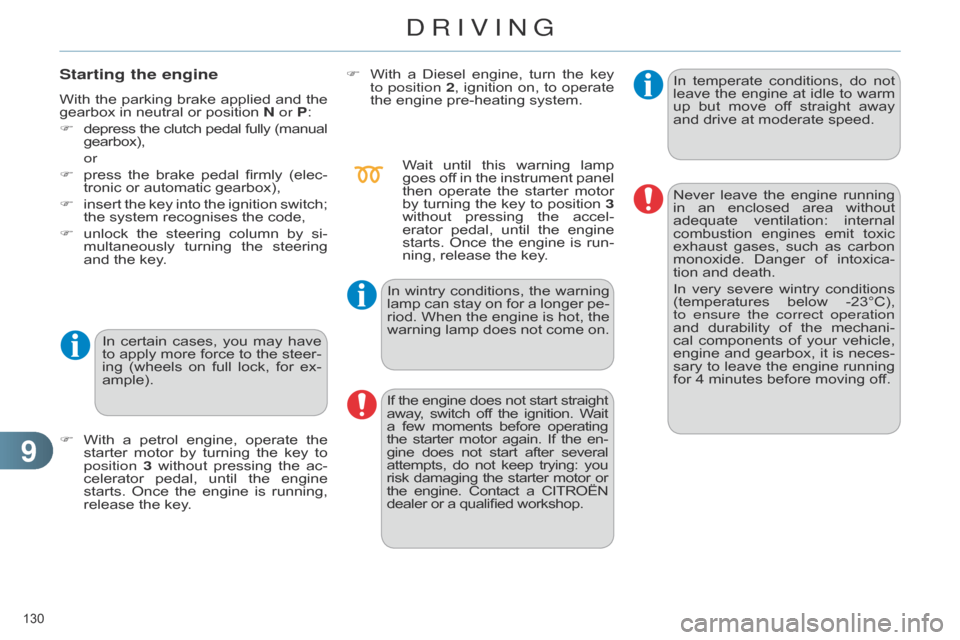
99
130ô
Starting the engine
Withô theô parking ô brake ô applied ô and ô the ô gearbox
ô in ô neutral ô or ô position ô N or P:
F
ô
depress
ô
the
ô
clutch
ô
pedal
ô
fully
ô
(manualô gearbox),
or
F
ô
press
ô
the
ô
brake
ô
pedal
ô
firmly
ô
(elec
-
tronic
ô or ô automatic ô gearbox),
F
ô
insert
ô
the
ô
key
ô
into
ô
the
ô
ignition
ô
switch;
ô
the
ô system ô recognises ô the ô code,
F
ô
unlock
ô
the
ô
steering
ô
column
ô
by
ô
si
-
multaneously
ô
turning
ô
the
ô
steering
ô
and
ô the ô key.
In
ô
certain
ô
cases,
ô
you
ô
may
ô
have
ô
to
ô apply ô more ô force ô to ô the ô steer-
ing
ô
(wheels
ô
on
ô
full
ô
lock,
ô
for
ô
ex
-
ample).
F
ô
With
ô
a
ô
petrol
ô
engine,
ô
operate
ô
the
ô
starter
ô
motor
ô
by
ô
turning
ô
the
ô
key
ô
to
ô
position 3
ô
without
ô
pressing
ô
the
ô
ac
-
celerator
ô
pedal,
ô
until
ô
the
ô
engine
ô
starts.
ô
Once
ô
the
ô
engine
ô
is
ô
running,
ô
release
ô the ô key. F
ô
With
ô
a
ô
Diesel
ô
engine,
ô
turn
ô
the
ô
key
ô to position
2, ô ignition ô on, ô to ô operate ô the
ô engine ô pre-heating ô system.
Wait
ô
until
ô
this
ô
warning
ô
lamp
ô
goes
ô
of
f ô
in
ô
the
ô
instrument
ô
panel
ô
then
ô
operate
ô
the
ô
starter
ô
motor
ô
by
ô
turning
ô
the
ô
key
ô
to
ô
positionô 3
without
ô
pressing
ô
the
ô
accel
-
erator
ô
pedal,
ô
until
ô
the
ô
engine
ô
starts.
ô
Once
ô
the
ô
engine
ô
is
ô
run
-
ning,
ô release ô the ô key.
In
ô
wintry
ô
conditions,
ô
the
ô
warning
ô
lamp
ô
can
ô
stay
ô
on
ô
for
ô
a
ô
longer
ô
pe
-
riod.
ô
When
ô
the
ô
engine
ô
is
ô
hot,
ô
the
ô
warning
ô
lamp
ô
does
ô
not
ô
come
ô
on.
If
ô the ô engine ô does ô not ô start ô straight
ô away
, ô
switch
ô
of
f ô
the
ô
ignition.
ô
W
ait
ô a
ô
few
ô
moments
ô
before
ô
operatingô the
ô
starter
ô
motor
ô
again.
ô
If
ô
the
ô
en
-
gine
ô
does
ô
not
ô
start
ô
after
ô
severalô attempts,
ô
do
ô
not
ô
keep
ô
trying:
ô
youô risk
ô
damaging
ô
the
ô
starter
ô
motor
ô
orô the
ô
engine.
ô
Contact
ô
a
ô
CITROûNô dealer
ô or ô a ô qualified ô workshop.In
ô
temperate
ô
conditions,
ô
do
ô
not
ô leave
ô the ô engine ô at ô idle ô to ô warm ô up
ô but ô move ô of f ô straight ô away ô
and
ô drive ô at ô moderate ô speed.
Never
ô
leave
ô
the
ô
engine
ô
running
ô
in
ô
an
ô
enclosed
ô
area
ô
without
ô
adequate
ô
ventilation:
ô
internal
ô
combustion
ô
engines
ô
emit
ô
toxic
ô
exhaust
ô
gases,
ô
such
ô
as
ô
carbon
ô
monoxide.
ô
Danger
ô
of
ô
intoxica
-
tion
ô and ô death.
In
ô
very
ô
severe
ô
wintry
ô
conditions
ô
(temperatures
ô
below
ô
-23ô¯C),
ô
to ensure the correct operation
and
ô
durability
ô
of
ô
the
ô
mechani
-
cal
ô
components
ô
of
ô
your
ô
vehicle,
ô
engine
ô
and
ô
gearbox,
ô
it
ô
is
ô
neces
-
sary
ô
to
ô
leave
ô
the
ô
engine
ô
running
ô
for
ô 4 ô minutes ô before ô moving ô off.
DRIVING
Page 133 of 328
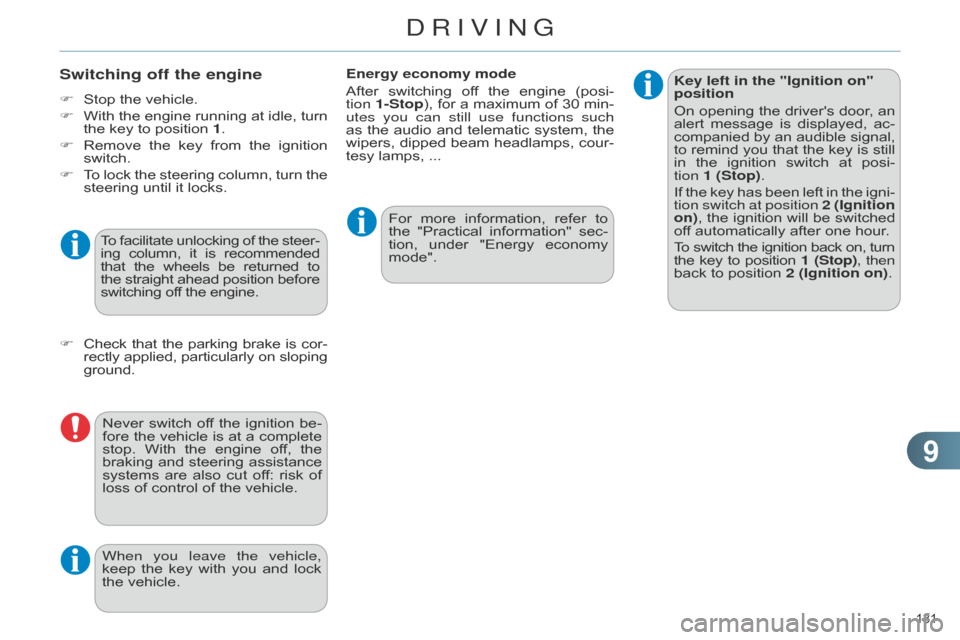
99
131ô
Key left in the "Ignition on"
position
Onô
opening
ô
the
ô
driver's
ô
door
, ô
an
ô
alert
ô
message
ô
is
ô
displayed,
ô
ac
-
companied
ô
by
ô
an
ô
audible
ô
signal,
ô
to
ô
remind
ô
you
ô
that
ô
the
ô
key
ô
is
ô
still
ô
in
ô
the
ô
ignition
ô
switch
ô
at
ô
posi
-
tion
1 (Stop).
If
ô
the
ô
key
ô
has
ô
been
ô
left
ô
in
ô
the
ô
igni
-
tion switch at position 2 (Ignition
on),
ô
the
ô
ignition
ô
will
ô
be
ô
switched
ô
of
f ô automatically ô after ô one ô hour.
To
ô
switch
ô
the
ô
ignition
ô
back
ô
on,
ô
turnô the
ô
key
ô
to
ô
position
ô
1 (Stop)
, then
back
ô to ô position ô 2 (Ignition on).Switching off the engine
Fô Stopô the ô vehicle.
F ô
With
ô
the
ô
engine
ô
running
ô
at
ô
idle,
ô
turn
ô
the
ô key ô to ô position ô 1.
F
ô
Remove
ô
the
ô
key
ô
from
ô
the
ô
ignition
ô
switch.
F
ô
T
o ô
lock
ô
the
ô
steering
ô
column,
ô
turn
ô
the
ô
steering
ô until ô it ô locks. Energy economy mode
After
ô switching ô of f ô the ô engine ô (posi -
tion 1-Stop ), ô for ô a ô maximum ô of ô 30 ô min -
utes you can still use functions such
as
ô
the
ô
audio
ô
and
ô
telematic
ô
system,
ô
the
ô
wipers,
ô
dipped
ô
beam
ô
headlamps,
ô
cour
-
tesy
ô lamps, ô ...
For
ô
more
ô
information,
ô
refer
ô
to
ô
the
ô
"Practical
ô
information"
ô
sec
-
tion,
ô
under
ô
"Energy
ô
economy
ô
mode".
T
o ô
facilitate
ô
unlocking
ô
of
ô
the
ô
steer
-
ing
ô
column,
ô
it
ô
is
ô
recommendedô that
ô
the
ô
wheels
ô
be
ô
returned
ô
toô the
ô
straight
ô
ahead
ô
position
ô
beforeô switching
ô off ô the ô engine.
F
ô
Check
ô
that
ô
the
ô
parking
ô
brake
ô
is
ô
cor
-
rectly
ô
applied,
ô
particularly
ô
on
ô
slopingô ground.Never
ô
switch
ô
of
f ô
the
ô
ignition
ô
be
-
fore
ô
the
ô
vehicle
ô
is
ô
at
ô
a
ô
complete
ô
stop.
ô
With
ô
the
ô
engine
ô
of
f, ô
the
ô
braking
ô
and
ô
steering
ô
assistance
ô
systems
ô
are
ô
also
ô
cut
ô
of
f: ô
risk
ô
of
ô
loss
ô of ô control ô of ô the ô vehicle.
When you leave the vehicle,
keep
ô
the
ô
key
ô
with
ô
you
ô
and
ô
lock
ô
the
ô vehicle.
DRIVING
Page 151 of 328
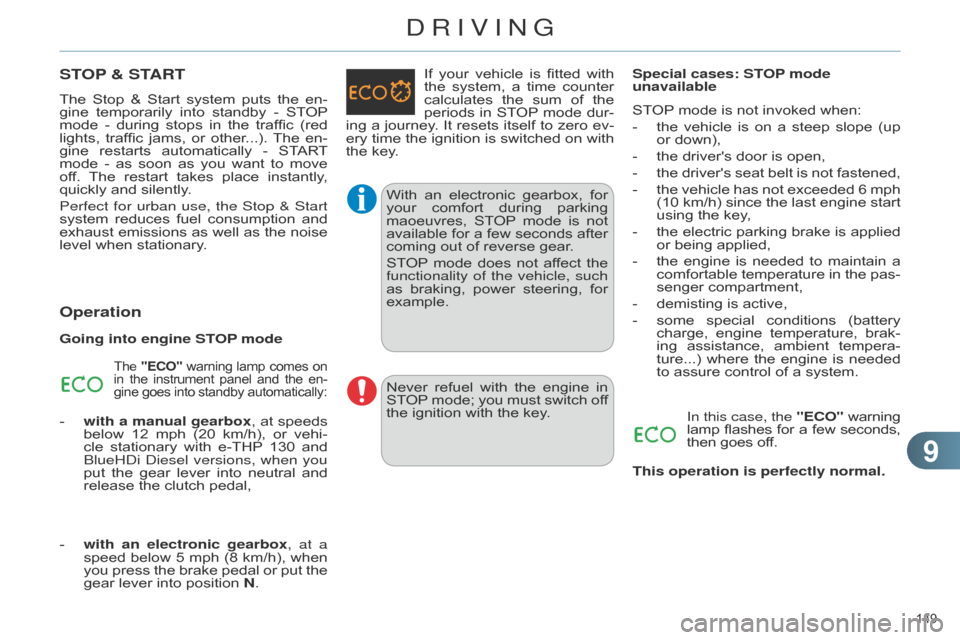
99
149ô
STOP & START
Theô Stopô & ô Startô system ô puts ô the ô en -
gine ô temporarily ô into ô standby ô - ô ST OPô mode
ô
-
ô
during
ô
stops
ô
in
ô
the
ô
traffic
ô
(red
ô
lights,
ô
traffic
ô
jams,
ô
or
ô
other
...). ô
The
ô
en
-
gine
ô
restarts
ô
automatically
ô
-
ô
ST
ART
ô mode
ô
-
ô
as
ô
soon
ô
as
ô
you
ô
want
ô
to
ô
move
ô
of
f. ô
The
ô
restart
ô
takes
ô
place
ô
instantly
, ô
quickly
ô and ô silently.
Perfect for urban use, the Stop & Start
system
ô
reduces
ô
fuel
ô
consumption
ô
and
ô
exhaust
ô
emissions
ô
as
ô
well
ô
as
ô
the
ô
noise
ô
level
ô when ô stationary.
Operation
Going into engine STOP mode
The "ECO" ô warning ô lamp ô comes ô onô in
ô the ô instrument ô panel ô and ô the ô en -
gine
ô goes ô into ô standby ô automatically:
-ô with a manual gearbox, ô at ô speeds ô below
ô 12 ô mph ô (20 ô km/h), ô or ô vehi -
cle
ô
stationary
ô
with
ô
e-THPô 130
ô
and
ô
b
lueH d i
d
iesel versions, when you
put
ô
the
ô
gear
ô
lever
ô
into
ô
neutral
ô
and
ô
release
ô the ô clutch ô pedal, If
ô
your
ô
vehicle
ô
is
ô
fitted
ô
with
ô
the
ô
system,
ô
a
ô
time
ô
counter
ô
calculates
ô
the
ô
sum
ô
of
ô
the
ô
periods
ô
in
ô
ST
OP
ô mode
ô
dur
-
ing ô
a
ô
journey
. ô
It
ô
resets
ô
itself
ô
to
ô
zero
ô
ev
-
ery ô
time
ô
the
ô
ignition
ô
is
ô
switched
ô
on
ô
with
ô
the
ô key.
- ô
with
an electronic gearbox, at a
speed
ô
below
ô
5
ô
mph
ô
(8
ô
km/h),
ô
when
ô
you
ô
press
ô
the
ô
brake
ô
pedal
ô
or
ô
put
ô
the
ô
gear
ô lever ô into ô position ô N.With
ô
an
ô
electronic
ô
gearbox,
ô
for
ô
your
ô
comfort
ô
during
ô
parking
ô
maoeuvres,
ô
ST
OP
ô mode
ô
is
ô
not
ô
available
ô
for
ô
a
ô
few
ô
seconds
ô
after
ô
coming
ô out ô of ô reverse ô gear.
STOP
ô mode
ô
does
ô
not
ô
af
fect ô
the
ô
functionality of the vehicle, such
as
ô
braking,
ô
power
ô
steering,
ô
for
ô
example.Special cases: ST
OP mode
unavailable
STOP
ô
mode ô is ô not ô invoked ô when:
- ô
the
ô
vehicle
ô
is
ô
on
ô
a
ô
steep
ô
slope
ô
(up
ô
or
ô down),
- ô
the
ô driver's ô door ô is ô open,
- ô
the
ô
driver's
ô
seat
ô
belt
ô
is
ô
not
ô
fastened,
-
ô
the
ô
vehicle
ô
has
ô
not
ô
exceeded
ô
6
ô
mph
ô
(10
ô
km/h)
ô
since
ô
the
ô
last
ô
engine
ô
start
ô
using
ô the ô key,
- ô
the
ô
electric
ô
parking
ô
brake
ô
is
ô
applied
ô
or
ô being ô applied,
- ô
the
ô
engine
ô
is
ô
needed
ô
to
ô
maintain
ô
a
ô
comfortable
ô
temperature
ô
in
ô
the
ô
pas
-
senger ô compartment,
- ô
demisting
ô is ô active,
- ô
some
ô
special
ô
conditions
ô
(battery
ô
charge,
ô
engine
ô
temperature,
ô
brak
-
ing ô
assistance,
ô
ambient
ô
tempera
-
ture...) ô
where
ô
the
ô
engine
ô
is
ô
needed
ô
to
ô assure ô control ô of ô a ô system.In this case, the "ECO"ô warningô lamp
ô flashes ô for ô a ô few ô seconds,ô then
ô goes ô off.
Neverô refuel ô with ô the ô engine ô in ô ST
OPô mode; ô you ô must ô switch ô of f ô
the
ô ignition ô with ô the ô key.
This operation is perfectly normal.
DRIVING
Page 152 of 328
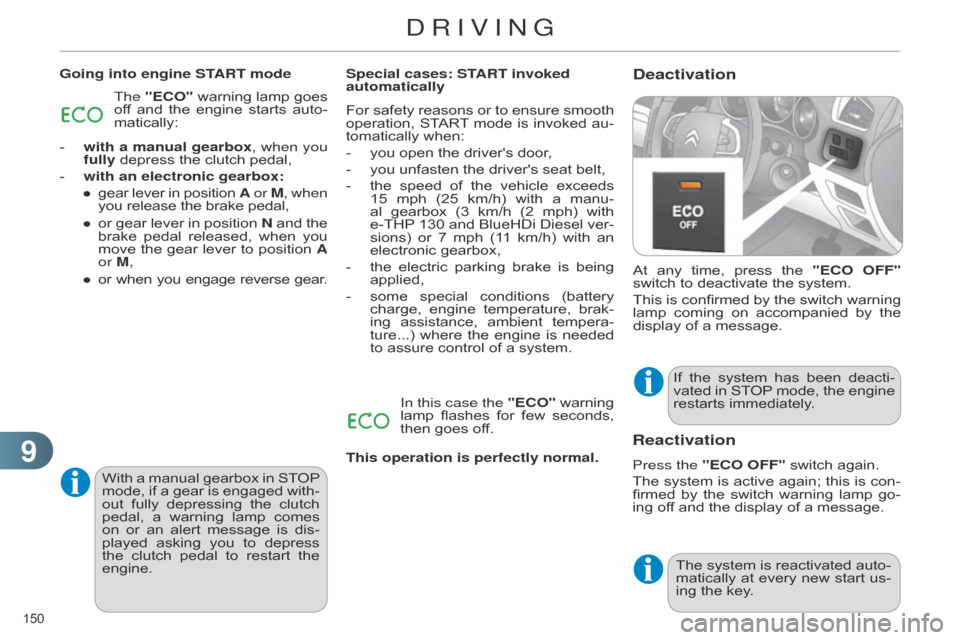
99
150ô
DeactivationGoing into engine START modeAt ô
any
ô
time,
ô
press
ô
the
ô
"ECO OFF"
switch
ô to ô deactivate ô the ô system.
This
ô
is
ô
confirmed
ô
by
ô
the
ô
switch
ô
warning
ô
lamp
ô
coming
ô
on
ô
accompanied
ô
by
ô
the
ô
display
ô of ô a ô message.
Special cases: START invoked
automatically
If
ô
the
ô
system
ô
has
ô
been
ô
deacti
-
vated
ô
in
ô
ST
OP
ô mode,
ô
the
ô
engine
ô
restarts
ô immediately.
The
"ECO"
ô
warning
ô
lamp
ô
goes
ô
of
f ô
and
ô
the
ô
engine
ô
starts
ô
auto
-
matically:
-
ô
with a manual gearbox
, when you
fully
ô depress ô the ô clutch ô pedal,
-
ô
with an electronic gearbox
:
ã
ô gear
ô
lever
ô
in
ô
position
ô
A or
M, when
you
ô release ô the ô brake ô pedal,
ã
ô
or
ô
gear
ô
lever
ô
in
ô
position
ô
N
ô
and
ô
the
ô
brake
ô
pedal
ô
released,
ô
when
ô
you
ô
move
ô
the
ô
gear
ô
lever
ô
to
ô
position
ô
A
or M,
ã
ô or
ô
when
ô
you
ô
engage
ô
reverse
ô
gear
.For
ô
safety
ô
reasons
ô
or
ô
to
ô
ensure
ô
smooth
ô
operation,
ô
ST
ART
ô mode
ô
is
ô
invoked
ô
au
-
tomatically
ô when:
-
ô
you
ô open ô the ô driver's ô door,
-
ô
you
ô unfasten ô the ô driver's ô seat ô belt,
-
ô
the
ô
speed
ô
of
ô
the
ô
vehicle
ô
exceeds
ô
15ô
mph ô
(25
ô
km/h)
ô
with
ô
a
ô
manu
-
al
ô
gearbox
ô
(3
ô
km/h
ô
(2
ô
mph)
ô
with
ô
e-THPô 130
ô
and
ô
BlueHDi
ô
Diesel
ô
ver
-
sions)
ô
or
ô
7ô
mph ô
(1
1 ô
km/h)
ô
with
ô
an
ô
electronic
ô gearbox,
-
ô
the
ô
electric
ô
parking
ô
brake
ô
is
ô
being
ô
applied,
-
ô
some
ô
special
ô
conditions
ô
(battery
ô
charge,
ô
engine
ô
temperature,
ô
brak
-
ing
ô
assistance,
ô
ambient
ô
tempera
-
ture...)
ô
where
ô
the
ô
engine
ô
is
ô
needed
ô
to
ô assure ô control ô of ô a ô system.
In this case the "ECO"
ô
warning
ô
lamp
ô
flashes
ô
for
ô
few
ô
seconds,
ô
then
ô goes ô off.
With
ô
a
ô
manual
ô
gearbox
ô
in
ô
ST
OP
ô mode,
ô
if
ô
a
ô
gear
ô
is
ô
engaged
ô
with
-
out
ô
fully
ô
depressing
ô
the
ô
clutch
ô
pedal,
ô
a
ô
warning
ô
lamp
ô
comes
ô
on
ô
or
ô
an
ô
alert
ô
message
ô
is
ô
dis
-
played
ô
asking
ô
you
ô
to
ô
depress
ô
the
ô
clutch
ô
pedal
ô
to
ô
restart
ô
the
ô
engine.
Reactivation
Press the "ECO OFF"ô switchô again.
The ô
system
ô
is
ô
active
ô
again;
ô
this
ô
is
ô
con
-
firmed
ô
by
ô
the
ô
switch
ô
warning
ô
lamp
ô
go
-
ing
ô off ô and ô the ô display ô of ô a ô message.
The
ô
system
ô
is
ô
reactivated
ô
auto
-
matically
ô
at
ô
every
ô
new
ô
start
ô
us
-
ing
ô the ô key.
This operation is perfectly normal.
DRIVING
Page 153 of 328
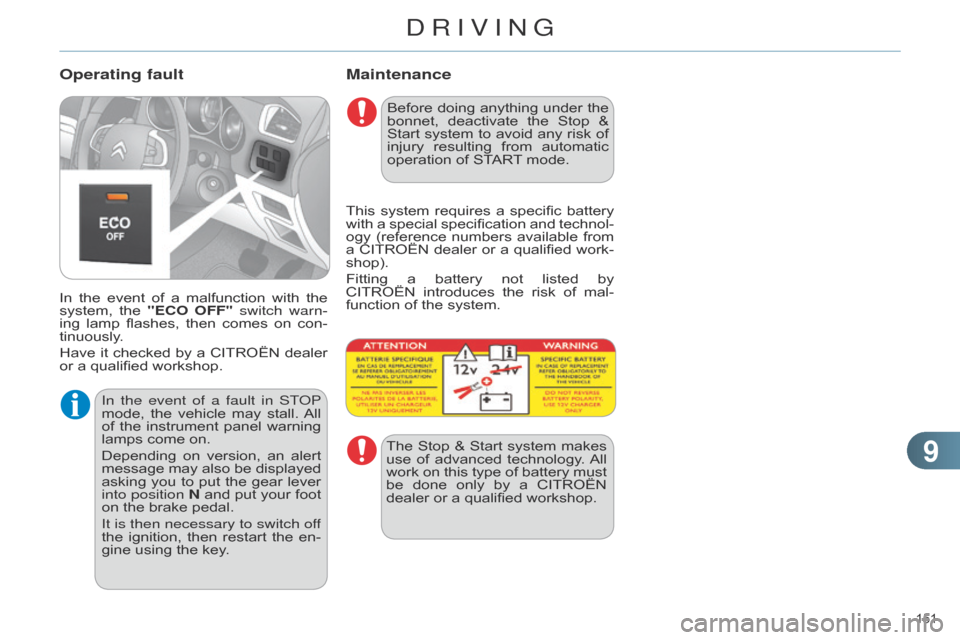
99
151ô
Maintenance
Inô theô event ô of ô a ô malfunction ô with ô the ô system,
ô the ô "ECO OFF" switch warn-
ing
ô
lamp
ô
flashes,
ô
then
ô
comes
ô
on
ô
con
-
tinuously.
Have
ô
it
ô
checked
ô
by
ô
a
ô
CITROûN
ô
dealer
ô
or
ô a ô qualified ô workshop.
Operating fault
Beforeô doingô anything ô under ô the ô bonnet,
ô deactivate ô the ô Stop ô & ô
Start
ô
system
ô
to
ô
avoid
ô
any
ô
risk
ô
of
ô
injury
ô
resulting
ô
from
ô
automatic
ô
operation
ô of ô START
ô
mode.
This
ô
system
ô
requires
ô
a
ô
specific
ô
battery
ô
with
ô
a
ô
special
ô
specification
ô
and
ô
technol
-
ogy
ô
(reference
ô
numbers
ô
available
ô
from
ô
a
ô
CITROûN
ô
dealer
ô
or
ô
a
ô
qualified
ô
work
-
shop).
Fitting
ô
a
ô
battery
ô
not
ô
listed
ô
by
ô
CITROûNô
introduces ô
the
ô
risk
ô
of
ô
mal
-
function
ô of ô the ô system.
The
ô
Stop
ô
&
ô
Start
ô
system
ô
makes
ô
use
ô
of
ô
advanced
ô
technology
. ô
All
ô
work
ô
on
ô
this
ô
type
ô
of
ô
battery
ô
must
ô
be
ô
done
ô
only
ô
by
ô
a
ô
CITROûN
ô
dealer
ô or ô a ô qualified ô workshop.
In the event of a fault in ST
o
P
mode,
ô
the
ô
vehicle
ô
may
ô
stall.
ô
All
ô
of
ô
the
ô
instrument
ô
panel
ô
warning
ô
lamps
ô
come
ô
on.
Depending
ô
on
ô
version,
ô
an
ô
alert
ô
message
ô
may
ô
also
ô
be
ô
displayed
ô
asking
ô
you
ô
to
ô
put
ô
the
ô
gear
ô
lever
ô
into position
N
ô
and
ô
put
ô
your
ô
foot
ô
on
ô
the
ô
brake
ô
pedal.
It is then necessary to switch off
the
ô
ignition,
ô
then
ô
restart
ô
the
ô
en
-
gine
ô
using
ô
the
ô
key.
DRIVING
Page 167 of 328

1010
165ô
FUEL TANK
Capacity of the tank: approximately
60 litres.
When the low fuel level in the
tank
ô
is
ô
reached,
ô
this
ô
warning
ô
lamp
ô
comes
ô
on
ô
in
ô
the
ô
instru
-
ment
ô
panel,
ô
accompanied
ô
by
ô
an
ô
audible
ô
warning
ô
and
ô
the
ô
dis
-
play
ô
of
ô
an
ô
alert
ô
message.
ô
When
ô
it
ô
first
ô
comes
ô
on,
ô
around
6 litres
of
ô fuel ô remain ô in ô the ô tank.
Until
ô
sufficient
ô
fuel
ô
has
ô
been
ô
added,
ô
ev
-
ery
ô
time
ô
the
ô
ignition
ô
is
ô
switched
ô
on,
ô
this
ô
warning
ô
lamp
ô
appears,
ô
accompanied
ô
by
ô
an
ô
audible
ô
signal
ô
and
ô
an
ô
alert
ô
mes
-
sage.
ô
When
ô
driving,
ô
this
ô
audible
ô
signal
ô
and
ô
the
ô
display
ô
of
ô
this
ô
alert
ô
message
ô
are
ô
repeated
ô
with
ô
increasing
ô
frequency
, ô
as
ô the ô level ô drops ô towards ô 0.
You
ô
must
ô
refuel
ô
as
ô
soon
ô
as
ô
possible
ô
to
ô
avoid
ô running ô out.
If you run out of fuel (
d iesel), refer also
to
ô "Checks".
Low fuel level Refuelling
Additionsô of
ô fuel ô must ô be ô of ô at ô least ô
5ô litres ô to ô be ô registered ô by ô the ô fuel ô
gauge.
Opening
ô
the
ô
filler
ô
cap
ô
may
ô
result
ô
in
ô
an
ô
inrush
ô
of
ô
air
. ô
This
ô
vacuum
ô
is
ô
entirely
ô
normal
ô
and
ô
results
ô
from
ô
the
ô
sealing
ô
of
ô
the
ô fuel ô system.
F
Press control
A ô
until
ô
the
ô
automatic
ô
opening
ô of ô the ô fuel ô flap ô is ô heard.
ô This
ô
control
ô
remains
ô
active
ô
for
ô
a
ô
few
ô
minutes
ô
after
ô
switching
ô
of
f ô
the
ô
igni
-
tion.
ô
If
ô
necessary
, ô
switch
ô
the
ô
ignition
ô
on
ô again ô to ô reactivate ô it.
F
ô
T
ake ô
care
ô
to
ô
select
ô
the
ô
pump
ô
that
ô
delivers
ô
the
ô
correct
ô
fuel
ô
for
ô
your
ô
ve
-
hicle.
If you are filling your tank to the top,
do not persist after the third cut-off;
this could cause your vehicle to mal-
function.
With Stop & Start, never refuel
with
ô
the
ô
system
ô
in
ô
ST
OP
ô mode;
ô
you
ô
must
ô
switch
ô
of
f
ô
the
ô
ignition
ô
with
ô
the
ô
key. F
ô
Introduce
ô
the
ô
nozzle
ô
so
ô
as
ô
to
ô
push
ô
in
ô the ô metal ô non-return ô flap ô B.
F
ô
Make
ô
sure
ô
that
ô
the
ô
nozzle
ô
is
ô
pushed
ô
in
ô
as
ô
far
ô
as
ô
possible
ô
before
ô
starting
ô
to
ô refuel ô (risk ô of ô blowback).
F
Maintainô this ô position ô while ô refuelling.
Fô Pushô the ô fuel ô flap ô to ô close ô it.
CHECKS